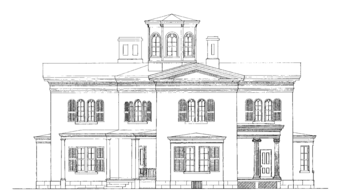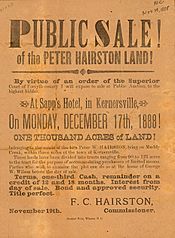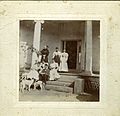Cooleemee facts for kids
|
Cooleemee
|
|

Cooleemee drawing from 1963
|
|
| Location | Terminus of SR 1812, Mocksville, North Carolina |
|---|---|
| Built | 1853–1855 |
| Architect | William H. Ranlett |
| Architectural style | Anglo-Grecian villa |
| NRHP reference No. | 73001334 |
Quick facts for kids Significant dates |
|
| Added to NRHP | March 20, 1973 |
| Designated NHL | June 2, 1978 |
Cooleemee, also known as the Cooleemee Plantation House, is a large house located in Davie County, North Carolina. It sits between the towns of Mocksville and Lexington, North Carolina, right by the Yadkin River. This historic house is a U.S. National Historic Landmark because of its special design. It was given this important title in 1978.
History of Cooleemee House
The Cooleemee house has a very unique shape. It's built like a Greek cross, which means it has four wings of equal length reaching out from a central, eight-sided area. This design was inspired by plans published by William H. Ranlett in his book The Architect in 1847. The house was built between 1853 and 1855 by Peter and Columbia Stuart Hairston.
About 300,000 bricks were used to build the house. These bricks were actually made right there on the property! The Cooleemee Plantation was started by Colonel Jesse A. Pearson. He named it "Cooleemee Hill" in 1814. The name "Cooleemee" comes from "Kulimi," a tribe of the Creek nation. Their village was near the Coosa and Tallapoosa Rivers. The Creek word means "the place where the white oaks grow."
In 1817, Peter Hairston, a veteran of the American Revolutionary War, bought the Cooleemee Hill Plantation. It was about 2,500-acre (10 km2) (about 10 square kilometers) at that time. By 1860, the plantation also had twenty-three homes for enslaved people. The main crop grown at Cooleemee was tobacco.
In 1997, the Hairston family, who still owned the house, took an important step to protect it. They donated a conservation easement to The LandTrust for Central North Carolina. This helped make sure the house and land would be preserved and not developed. At that time, the plantation still had about 1,900 acres (7.7 km2) (about 7.7 square kilometers) of farmland. It was also surrounded by a two-mile (3 km) stretch of the Yadkin River, which is home to more than 200 types of birds.
Cooleemee Plantation was officially named a National Historic Landmark in 1978.
The Hairston Family
In 1999, a book called The Hairstons: An American Family In Black And White was published by Henry Wiencek. This book tells the story of the Hairston family, who still own Cooleemee. It also shares the history of the plantation over the last 150 years.
The Hairston family has both Black and white members, a result of the history of slavery. Even today, these different branches of the family continue to hold reunions at Cooleemee. These gatherings help them honor their family's history and their deep roots in the area.
Peter Wilson Hairston, who owned the property at the end of the 20th century, wrote a book in 1986. His book shared the history of the enslaved people who lived on the family's land. This research helped others learn more about the family and the property. Peter Wilson Hairston passed away in February 2007 in the very same bed where he was born.
Archaeological Discoveries
Many interesting things have been found at Cooleemee Plantation. About 175 arrowheads were discovered on the western side of the Yadkin River. Experts like Dr. Joffre L. Coe and Dr. James Bingham studied these arrowheads.
They found that the arrowheads came from different groups of people and different time periods. Some of them date back to about 7000 BCE (Before Common Era) up to the 18th century. Some very old arrowheads are from 8000 to 8500 years ago. The oldest one, called a Hardaway Point, is about 9000 years old!
Images for kids





